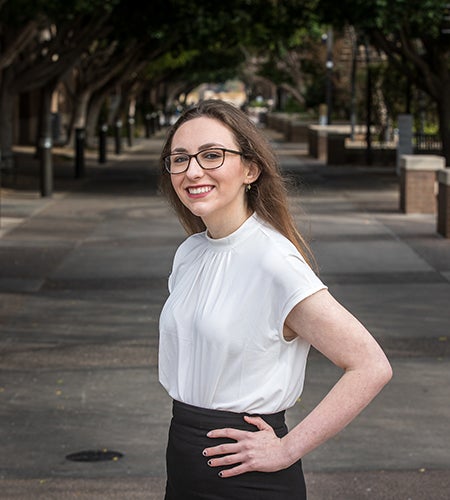With ASU mentors, high schoolers pursue research as varied as their interests

For most teens, the break between semesters is a relaxed time of unstructured adventure. Driving around with friends. Meeting at the mall. Lounging by the pool.
While these past months were uncommon due to the COVID-19 pandemic, for a handful of students from the Gary K. Herberger Young Scholars Academy this break was always going to be out of the ordinary.
Going into their final year, graduating seniors at HYSA are offered the opportunity to be mentored by an Arizona State University professor and conduct firsthand work on a research project.
“It started out as an opportunity for our high school students to interact with real, authentic research being conducted at ASU,” said Kimberly Lansdowne, HYSA’s founding executive director. “Since its beginning, mentorships have morphed into opportunities for our students to confirm their passions and, maybe, discover that what they always thought they wanted to do, their childhood wishes, are not true anymore.”
The mentorships have become the capstone experience for HYSA students, she said.
Students have worked on research projects as varied as their interests, she says, from understanding shark cartilage to helping to develop a COVID-19 vaccine and from understanding how ancients made stone tools to exploring black holes in space.
Started in 2011, HYSA is an ASU-supported and Mary Lou Fulton Teachers College-affiliated learning environment located on the West campus and designed for highly gifted students in grades 7-12 .

Herberger Young Scholars Academy senior Mackenzie Brooks worked with the Morrison Institute of Public Policy on how adverse childhood experiences impacted someone’s likelihood of developing a chronic illness. Her research work is now the foundation of a paper that will be presented to the Arizona Adverse Childhood Experiences Consortium. Photo by Charlie Leight/ASU
The daughter of two attorneys, Mackenzie Brooks, 17, has developed — not surprisingly — an interest in the law but also in public policy. HYSA secured for her a mentorship at ASU’s Morrison Institute of Public Policy, working on how adverse childhood experiences impacted someone’s likelihood of developing a chronic illness later in life.
Starting in September, Brooks spent about four hours a week combing through existing research on the topic.
“I was surprised to learn that these incidents have a direct link to increases in actual diseases, like heart disease,” she said. “Working on this has made me a lot more interested in the family side of law. I found it fascinating even though it wasn’t what I was planning to go into.”
Brooks' research work is now the foundation of a paper that will be presented to the Arizona Adverse Childhood Experiences Consortium, which will help members craft policy initiatives.
“I was blown away by the quality of her analysis and the synthesis of her writing,” said her mentor in the project, Erica Quintana, a Morrison Institute senior policy analyst. “Definitely far above what I was expecting from a high school student.”
When she was younger, Annika Erickson, 17, began spending quite a bit of time at a family friend’s house, where they spoke almost exclusively Hebrew. Rather than be left out of the conversation, Erickson instead taught herself the language.
Her interest in how people learn languages led her to a mentorship looking at how basic vocabulary was introduced on a Sesame Street-type television show in Israel. Each week, beginning in the summer, Erickson spent four hours a week watching the show and tracking when new words were introduced. The research project is set to end in May.
“I’m passionate about language learning,” she said. “Before the project, I had a pretty solid base but this is reenforcing my religious and language skills and understanding.”
Working on the research with her mentor, Judith Shemer, senior lecturer at ASU’s School of International Letters and Cultures, solidified Erickson’s plans to major in speech pathology in college.
The biggest thing influencing the world became the topic of Tal Spector’s mentorship over the summer. Along with a partner, Spector, 16, conducted research into whether social media posts could be used to accurately identify outbreaks of COVID-19. Working from a database of about 1,000 posts on Twitter, Spector found that they could correctly identify outbreaks 95% of the time.
“This has a lot of potential to effectively track diseases,” said Spector, who submitted the research paper into the ASU Sustainability Solutions Festival. He’s now working on a second research project with his ASU mentor — Kuai Xu, associate professor in the School of Mathematical and Natural Sciences — creating a system to alert someone when their home Wi-Fi is attacked by an outside user.
“I’m not sure how I’m going to go about creating it,” Spector said. “I went into this having zero experience and knowing very little, but now I know a lot about how routers work and how Wi-Fi systems interact.”
He intends to major in computer science but hasn’t settled on where he might attend.
Learn more about Herberger Young Scholars Academy at herbergeracademy.asu.edu.
Written by DJ Burrough. Top photos by Charlie Leight/ASU (shark image) and iStock
More Arts, humanities and education

Upcoming exhibition brings experimental art and more to the West Valley campus
Ask Tra Bouscaren how he got into art and his answer is simple.“Art saved my life when I was 19,” he says. “I was in a dark place and art showed me the way out.”Bouscaren is an …

ASU professor, alum named Yamaha '40 Under 40' outstanding music educators
A music career conference that connects college students with such industry leaders as Timbaland. A K–12 program that incorporates technology into music so that students are using digital tools to…

ASU's Poitier Film School to host master classes, screening series with visionary filmmakers
Rodrigo Reyes, the acclaimed Mexican American filmmaker and Guggenheim Fellow whose 2022 documentary “Sansón and Me” won the Best Film Award at Sheffield DocFest, has built his career with films that…

